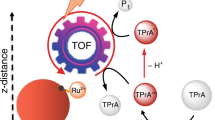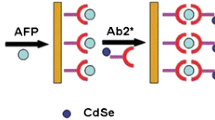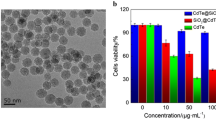Abstract
Electrochemiluminescence (ECL) can be produced through two main routes: annihilation route and coreactant route. The vast majority of applications of ECL are based on coreactant ECL which can be generated in aqueous media at relatively low potentials compared with organic solvents. However, the development of more efficient ECL systems remains a compelling goal. Co-reaction accelerator (CRA) can significantly enhance the ECL signal through promoting more production of the coreactant intermediate. Compared with other ECL enhancement strategies, the CRA protocol is distinctive owing to its diverse, simple, and highly effective features. Various species such as inorganic compound, organic compound, and nanomaterials (NMs) have been developed as CRA and NM CRA has gained particular attention owing to their unique properties of excellent catalytic behavior and large surface area. By integration with the inherent advantages of ECL, bioanalysis based on CRA-enhanced ECL showed excellent performance such as ultrahigh sensitivity, wide dynamic range, low cost, simple instrumentation, and measurements in complex media. It has been extensively applied in various fields including clinical diagnosis, environmental monitoring, and food safety. Therefore, it is of great interest to present a systematic and critical review on the advances in ECL CRA. Herein, the recent progress on CRA and its applications in ECL bioanalysis are summarized by illustrating some representative work and a discussion of the future development trends of CRA ECL is offered.
Graphical abstract





Similar content being viewed by others
References
Richter MM. Electrochemiluminescence (ECL). Chem Rev. 2004;104:3003–36.
Hu LZ, Xu GB. Applications and trends in electrochemiluminescence. Chem Soc Rev. 2010;39:3275–304.
Li LL, Chen Y, Zhu JJ. Recent advances in electrochemiluminescence analysis. Anal Chem. 2017;89:358–71.
Babamiri B, Bahari D, Salimi A. Highly sensitive bioaffinity electrochemiluminescence sensors: recent advances and future directions. Biosens Bioelectron. 2019;142:111530.
Chen Y, Zhou SW, Li LL, Zhu JJ. Nanomaterials-based sensitive electrochemiluminescence biosensing. Nano Today. 2017;12:98–115.
Liu YH, Guo WL, Su B. Recent advances in electrochemiluminescence imaging analysis based on nanomaterials and micro−/nanostructures. Chin Chem Lett. 2019;30:1593–9.
Liu YJ, Liu YX, Qiao L, Liu Y, Liu BH. Advances in signal amplification strategies for electrochemical biosensing. Curr Opin Electrochem. 2018;12:5–12.
Shi ZX, Li GK, Hu YF. Progress on the application of electrochemiluminescence biosensor based on nanomaterials. Chin Chem Lett. 2019;30:1600–6.
Sun JW, Sun H, Liang ZQ. Nanomaterials in electrochemiluminescence sensors. ChemElectroChem. 2017;4:1651–62.
Zhuo Y, Wang HJ, Lei YM, Zhang P, Liu JL, Chai YQ, et al. Electrochemiluminescence biosensing based on different modes of switching signals. Analyst. 2018;143:3230–48.
Khonsari YN, Sun SG. Recent trends in electrochemiluminescence aptasensors and their applications. Chem Commun. 2017;53:9042–54.
Li SJ, Liu Y, Ma Q. Nanoparticle-based electrochemiluminescence cytosensors for single cell level detection. TrAC Trends Anal Chem. 2019;110:277–92.
Chen XQ, Liu Y, Ma Q. Recent advances in quantum dot-based electrochemiluminescence sensors. J Mater Chem C. 2018;6:942–59.
Fiorani A, Merino JP, Zanut A, Criado A, Valenti G, Prato M, et al. Advanced carbon nanomaterials for electrochemiluminescent biosensor applications. Curr Opin Electrochem. 2019;16:66–74.
Zou R, Teng X, Lin YJ, Lu C. Graphitic carbon nitride-based nanocomposites electrochemiluminescence systems and their applications in biosensors. TrAC Trends Anal Chem. 2020;132:116054.
Han S, Zhao YH, Zhang ZC, Xu GB. Recent advances in electrochemiluminescence and chemiluminescence of metal nanoclusters. Molecules. 2020;25:5208.
Zhou JJ, Li Y, Wang WJ, Tan XC, Lu ZC, Han HY. Metal-organic frameworks-based sensitive electrochemiluminescence biosensing. Biosens Bioelectron. 2020;164:112332.
Kannan P, Chen J, Su FM, Guo ZY, Huang YJ. Faraday-cage-type electrochemiluminescence immunoassay: a rise of advanced biosensing strategy. Anal Chem. 2019;91:14792–802.
Lu HJ, Xu JJ, Zhou H, Chen HY. Recent advances in electrochemiluminescence resonance energy transfer for bioanalysis: Fundamentals and applications. TrAC Trends Anal Chem. 2020;122:115746.
Ma C, Cao Y, Gou XD, Zhu JJ. Recent progress in electrochemiluminescence sensing and imaging. Anal Chem. 2020;92:431–54.
Wei X, Zhu MJ, Yan H, Lu CS, Xu JJ. Recent advances in aggregation-induced electrochemiluminescence. Chem Eur J. 2019;25:12671–83.
Hu LY, Wu Y, Xu M, Gu WL, Zhu CZ. Recent advances in co-reaction accelerators for sensitive electrochemiluminescence analysis. Chem Commun. 2020;56:10989–99.
Ma MN, Zhuo Y, Yuan R, Chai YQ. New signal amplification strategy using semicarbazide as coreaction accelerator for highly sensitive electrochemiluminescent aptasensor construction. Anal Chem. 2015;87:11389–97.
Yu YQ, Zhang HY, Chai YQ, Yuan R, Zhuo Y. A sensitive electrochemiluminescent aptasensor based on perylene derivatives as a novel co-reaction accelerator for signal amplification. Biosens Bioelectron. 2016;85:8–15.
Sun MF, Liu JL, Chai YQ, Zhang J, Tang Y, Yuan R. Three-dimensional cadmium telluride quantum dots−DNA nanoreticulation as a highly efficient electrochemiluminescent emitter for ultrasensitive detection of microRNA from cancer cells. Anal Chem. 2019;91:7765–73.
Guo YS, Shang XX, Liu F, Hu YH, Li S, Liu J, et al. Novel enhancer for luminol-AuNP electrochemiluminescence and decoration on RNA membranes for effective cytosensing. ACS Appl Bio Mater. 2018;1:1647–55.
Tang HJ, Chen WX, Li DD, Duan XL, Ding SJ, Zhao M, et al. Luminol-based ternary electrochemiluminescence nanospheres as signal tags and target-triggered strand displacement reaction as signal amplification for highly sensitive detection of Helicobacter pylori DNA. Sens Actuators B Chem. 2019;293:304–11.
Liu W, Chen AY, Li SK, Peng KF, Chai YQ, Yuan R. Perylene derivative/luminol nanocomposite as a strong electrochemiluminescence emitter for construction of an ultrasensitive microRNA biosensor. Anal Chem. 2019;91:1516–23.
Wang SS, Zhao YY, Wang MM, Li HJ, Saqib M, Ge CH, et al. Enhancing luminol electrochemiluminescence by combined use of cobalt-based metal organic frameworks and silver nanoparticles and its application in ultrasensitive detection of cardiac troponin I. Anal Chem. 2019;91:3048–54.
Khoshfetrat SM, Khoshsafar H, Afkhami A, Mehrgardi MA, Bagheri H. Enhanced visual wireless electrochemiluminescence immunosensing of prostate-specific antigen based on the luminol loaded into MIL-53(Fe)-NH2 accelerator and hydrogen evolution reaction mediation. Anal Chem. 2019;91:6383–90.
Liu ZT, Li SK, Wei RT, Chen AY, Chai YQ, Yuan R, et al. CuS porous nanospheres as a novel noble metal-free co-reaction accelerator for enhancing electrochemiluminescence and sensitive immunoassay of mucin 1. Sens Actuators B Chem. 2018;274:110–5.
Wang C, Zhang N, Li YY, Yang L, Wei D, Yan T, et al. Cobalt-based metal-organic frameworks as co-reaction accelerator for enhancing electrochemiluminescence behavior of N-(aminobutyl)-N-(ethylisoluminol) and ultrasensitive immunosensing of amyloid-β protein. Sens Actuators B Chem. 2019;291:319–28.
Yang L, Fan DW, Zhang Y, Ding CF, Wu D, Wei Q, et al. Ferritin-based electrochemiluminescence nanosurface energy transfer system for procalcitonin detection using HWRGWVC heptapeptide for site-oriented antibody immobilization. Anal Chem. 2019;91:7145–52.
Li SK, Liu ZT, Li JY, Chen AY, Chai YQ, Yuan R, et al. Enzyme-free target recycling and double-output amplification system for electrochemiluminescent assay of mucin 1 with MoS2 nanoflowers as co-reaction accelerator. ACS Appl Mater Interfaces. 2018;10:14483–90.
Jiang XY, Wang HJ, Wang HJ, Zhuo Y, Yuan R, Chai YQ. Electrochemiluminescence biosensor based on 3-D DNA nanomachine signal probe powered by protein-aptamer binding complex for ultrasensitive mucin 1 detection. Anal Chem. 2017;89:4280–6.
Yang F, Jiang XY, Zhong X, Wei SP, Yuan R. Highly sensitive electrochemiluminescence detection of mucin1 based on V2O5 nanospheres as peroxidase mimetics to catalyze H2O2 for signal amplification. Sens Actuators B Chem. 2018;265:126–33.
Li XY, Xu Y, Chen YX, Wang C, Jiang JJ, Dong JT, Yan H, Du XZ. Dual enhanced electrochemiluminescence of aminated Au@SiO2/CdS quantum dot superstructures: electromagnetic field enhancement and chemical enhancement. ACS Appl Mater Interfaces. 2019;11:4488–99.
Zhao J, Liang WB, Lei YM, Ou YX, Chai YQ, Yuan R, et al. An efficient electrochemiluminescence amplification strategy via bis-coreaction accelerator for sensitive detection of laminin to monitor overnutrition associated liver damage. Biosens Bioelectron. 2017;98:317–24.
Fang DD, Zheng XQ, Yi H, Dai H, Hong ZS, Peng YR, et al. A H2O2-free electrochemiluminescence immunosensor constructed on all-in-one bioprobe comprised of TiO2-B supported fluoro-coumarin silicon phthalocyanine for deoxynivalenol sensing. Sens Actuators B Chem. 2019;283:407–14.
Wu FF, Zhou Y, Zhang H, Yuan R, Chai YQ. Electrochemiluminescence peptide-based biosensor with hetero-nanostructures as coreaction accelerator for the ultrasensitive determination of tryptase. Anal Chem. 2018;90:2263–70.
Zhang XL, Li WM, Zhou Y, Chai YQ, Yuan R. An ultrasensitive electrochemiluminescence biosensor for microRNA detection based on luminol-functionalized Au NPs@ZnO nanomaterials as signal probe and dissolved O2 as coreactant. Biosens Bioelectron. 2019;135:8–13.
Yang L, Jia Y, Wu D, Zhang Y, Ju HX, Du Y, et al. Synthesis and application of CeO2/SnS2 heterostructures as highly-efficient coreaction accelerator in luminol-dissolved O2 system for ultrasensitive biomarkers immunoassay. Anal Chem. 2019;91:14066–73.
Hu QY, Yang JY, Zheng ZY, Ding YP, Chen YW, Gao WH. In situ H2O2 generation with gold nanoflowers as the coreactant accelerator for enzyme-free electrochemiluminescent immunosensing. Biosens Bioelectron. 2019;143:111627.
Liu JL, Tang ZL, Zhuo Y, Chai YQ, Yuan R. Ternary electrochemiluminescence system based on rubrene microrods as luminophore and Pt nanomaterials as coreaction accelerator for ultrasensitive detection of microRNA from cancer cells. Anal Chem. 2017;89:9108–15.
Yang SS, Jiang MH, Chai YQ, Yuan R, Zhuo Y. Application of antibody-powered triplex-DNA nanomachine to electrochemiluminescence biosensor for the detection of anti-digoxigenin with improved sensitivity versus cycling strand displacement reaction. ACS Appl Mater Interfaces. 2018;10:38648–55.
Liu JL, Tang ZL, Zhang JQ, Chai YQ, Zhuo Y, Yuan R. Morphology-controlled 9,10-diphenylanthracene nanoblocks as electrochemiluminescence emitters for microRNA detection with one-step DNA walker amplification. Anal Chem. 2018;90:5298–305.
Yang X, Yu YQ, Peng LZ, Lei YM, Chai YQ, Yuan R, et al. Strong electrochemiluminescence from MOF accelerator enriched quantum dots for enhanced sensing of trace cTnI. Anal Chem. 2018;90:3995–4002.
Lei YM, Wen RX, Zhou J, Chai YQ, Yuan R, Zhuo Y. Silver ions as novel coreaction accelerator for remarkably enhanced electrochemiluminescence in a PTCA−S2O82− system and its application in an ultrasensitive assay for mercury ions. Anal Chem. 2018;90:6851–8.
Lei YM, Zhao M, Wang A, Yu YQ, Chai YQ, Yuan R, et al. Electrochemiluminescence of supramolecular nanorods and their application in the “on–off–on” detection of copper ions. Chem Eur J. 2016;22:8207–14.
Nie YX, Liu Y, Zhang Q, Su XG, Ma Q. Novel coreactant modifier-based amplified electrochemiluminescence sensing method for point-of-care diagnostics of galactose. Biosens Bioelectron. 2019;138:111318.
Wang YF, Zhang Y, Sha HF, Xiong X, Jia NQ. Design and biosensing of a ratiometric electrochemiluminescence resonance energy transfer aptasensor between a g-C3N4 nanosheet and Ru@MOF for amyloid-β protein. ACS Appl Mater Interfaces. 2019;11:36299–306.
Zhang C, Fan Y, Zhang H, Chen SH, Yuan R. An ultrasensitive signal-on electrochemiluminescence biosensor based on Au nanoclusters for detecting acetylthiocholine. Anal Bioanal Chem. 2019;411:905–13.
Jia Y, Yang L, Xue JW, Ren X, Zhang N, Fan DW, et al. Highly-branched Cu2O as well-ordered co-reaction accelerator for amplifying electrochemiluminescence response of gold nanoclusters and procalcitonin analysis based on protein bioactivity maintenance. Biosens Bioelectron. 2019;144:111676.
Fang JL, Zhao GH, Dong X, Li X, Miao JC, Wei Q, et al. Ultrasensitive electrochemiluminescence immunosensor for the detection of amyloid-β proteins based on resonance energy transfer between g-C3N4 and Pd NPs coated NH2-MIL-53. Biosens Bioelectron. 2019;142:111517.
Jiang MH, Lu P, Lei YM, Chai YQ, Yuan R, Zhuo Y. Self-accelerated electrochemiluminescence emitters of Ag@SnO2 nanoflowers for sensitive detection of cardiac troponin T. Electrochim Acta. 2018;271:464–71.
Lei YM, Zhou J, Chai YQ, Zhuo Y, Yuan R. SnS2 quantum dots as new emitters with strong electrochemiluminescence for ultrasensitive antibody detection. Anal Chem. 2018;90:12270–7.
Liao HX, Zhou Y, Chai YQ, Yuan R. An ultrasensitive electrochemiluminescence biosensor for detection of microRNA by in-situ electrochemically generated copper nanoclusters as luminophore and TiO2 as coreaction accelerator. Biosens Bioelectron. 2018;114:10–4.
Zhou Y, Chen MX, Zhuo Y, Chai YQ, Xu WJ, Yuan R. In situ electrodeposited synthesis of electrochemiluminescent Ag nanoclusters as signal probe for ultrasensitive detection of cyclin-D1 from cancer cells. Anal Chem. 2017;89:6787–93.
Fang QC, Lin ZH, Lu FS, Chen YW, Huang XC, Gao WH. A sensitive electrochemiluminescence immunosensor for the detection of PSA based on CdWS nanocrystals and Ag+@UIO-66-NH2 as a novel coreaction accelerator. Electrochim Acta. 2019;302:207–15.
Jia Y, Yang L, Xue JW, Zhang N, Fan DW, Ma HM, et al. Bioactivity-protected electrochemiluminescence biosensor using gold nanoclusters as the low-potential luminophor and Cu2S snowflake as co-reaction accelerator for procalcitonin analysis. ACS Sens. 2019;4:1909–16.
Zhou Y, Chen SH, Luo XL, Chai YQ, Yuan R. Ternary electrochemiluminescence nanostructure of au nanoclusters as a highly efficient signal label for ultrasensitive detection of cancer biomarkers. Anal Chem. 2018;90:10024–30.
Zhang R, Zhong X, Chen AY, Liu JL, Li SK, Chai YQ, et al. Novel Ru(bpy)2(cpaphen)2+/TPrA/TiO2 ternary ECL system: an efficient platform for the detection of glutathione with Mn2+ as substitute target. Anal Chem. 2019;91:3681–6.
Jian YN, Wang H, Sun XL, Zhang LN, Cui K, Ge SG, Yu JH. Electrochemiluminescence cytosensing platform based on Ru(bpy)32+@silica-Au nanocomposite as luminophore and AuPd nanoparticles as coreaction accelerator for in situ evaluation of intracellular H2O2. Talanta. 2019;199:485–90.
Ye MM, Chen ZL, Liu XW, Ben Y, Shen JM. Ozone enhanced activity of aqueous titanium dioxide suspensions for photodegradation of 4-chloronitrobenzene. J Hazard Mater. 2009;167:1021–7.
Xu GB, Cheng L, Dong SJ. Effects of heteropoly acids and surfactant on electrochemiluminescence of tris(2,2′-bipyridine) ruthenium(II). Anal Lett. 1999;32(11):2311–26.
Xu GB, Pang HL, Xu B, Dong SJ, Wong KY. Enhancing the electrochemiluminescence of tris(2,2′-bipyridyl)ruthenium(II) by ionic surfactants. Analyst. 2005;130:541–4.
Xu SJ, Liu Y, Wang TH, Li JH. Highly sensitive electrogenerated chemiluminescence biosensor in profiling protein kinase activity and inhibition using gold nanoparticle as signal transduction probes. Anal Chem. 2010;82:9566–72.
Jie GF, Zhang JJ, Wang DC, Cheng C, Chen HY, Zhu JJ. Electrochemiluminescence immunosensor based on CdSe nanocomposites. Anal Chem. 2008;80:4033–9.
Shoji E, Freund MS. Potentiometric sensors based on the inductive effect on the pKa of poly(aniline): a nonenzymatic glucose sensor. J Am Chem Soc. 2001;123:3383–4.
Wang JX, Zhuo Y, Zhou Y, Yuan R, Chai YQ. Electrochemiluminescence immunosensor based on multifunctional luminol-capped AuNPs@Fe3O4 nanocomposite for the detection of mucin-1. Biosens Bioelectron. 2015;71:407–13.
Mayer M, Takegami S, Neumeier M, Rink S, von Wangelin AJ, Schulte S, et al. Electrochemiluminescence bioassays with a water-soluble luminol derivative can outperform fluorescence assays. Angew Chem Int Ed. 2018;57:408–11.
Zhang TB, Lu YC, Luo GS. Synthesis of hierarchical iron hydrogen phosphate crystal as a robust peroxidase mimic for stable H2O2 detection. ACS Appl Mater Interfaces. 2014;6:14433–8.
Li Q, Wang SX, Kirschbaum K, Lambright KJ, Das A, Jin RC. Heavily doped Au25–xAgx(SC6H11)18− nanoclusters: silver goes from the core to the surface. Chem Commun. 2016;52:5194–7.
Liu J, Ren J, Bao XJ, Gao W, Wu CL, Zhao YB. pH-switchable fluorescent probe for spatially-confined visualization of intracellular hydrogen peroxide. Anal Chem. 2016;88:5865–70.
Qiao YL, Li Y, Fu W, Guo ZH, Zheng XW. Enhancing the electrochemiluminescence of luminol by chemically modifying the reaction microenvironment. Anal Chem. 2018;90:9629–36.
Wu JJX, Wang XY, Wang Q, Lou ZP, Li SR, Zhu YY, et al. Nanomaterials with enzyme-like characteristics (nanozymes): next-generation artificial enzymes (II). Chem Soc Rev. 2019;48:1004–76.
Liu GD, Wu H, Wang J, Lin YH. Apoferritin-templated synthesis of metal phosphate nanoparticle labels for electrochemical immunoassay. Small. 2006;2(10):1139–43.
Dostalova S, Cerna T, Hynek D, Koudelkova Z, Vaculovic T, Kopel P, et al. Site-directed conjugation of antibodies to apoferritin nanocarrier for targeted drug delivery to prostate cancer cells. ACS Appl Mater Interfaces. 2016;8(23):14430–41.
Edston E, van Hage-Hamsten M. β-Tryptase measurements post-mortem in anaphylactic deaths and in controls. Forensic Sci Int. 1998;93:135–42.
Fineschi V, Cecchi R, Centini F, Reattelli LP, Turillazzi E. Immunohistochemical quantification of pulmonary mast-cells and post-mortem blood dosages of tryptase and eosinophil cationic protein in 48 heroin-related deaths. Forensic Sci Int. 2001;120:189–94.
Zaleska K, Przybyła A, Kulcenty K, Wichtowski M, Mackiewicz A, Suchorska W, et al. Wound fluids affect miR-21, miR-155 and miR-221 expression in breast cancer cell lines, and this effect is partially abrogated by intraoperative radiation therapy treatment. Oncol Lett. 2017;14:4029–36.
Gao Y, Xie XD, Li FQ, Lu YS, Li T, Lian S, et al. A novel nanomissile targeting two biomarkers and accurately bombing CTCs with doxorubicin. Nanoscale. 2017;9:5624–40.
Arya SK, Lim B, Rahman ARA. Enrichment, detection and clinical significance of circulating tumor cells. Lab Chip. 2013;13:1995–2027.
Sun YJ, Luo MC, Meng XX, Xiang J, Wang L, Ren QS, et al. Graphene/intermetallic PtPb nanoplates composites for boosting electrochemical detection of H2O2 released from cells. Anal Chem. 2017;89(6):3761–7.
Wang LY, Peng XL, Fu HJ, Huang C, Li YP, Liu ZM. Recent advances in the development of electrochemical aptasensors for detection of heavy metals in food. Biosens Bioelectron. 2020;147:111777.
Kim KH, Kabir E, Jahan SA. A review on the distribution of Hg in the environment and its human health impacts. J Hazard Mater. 2016;306:376–85.
Liu SD, Feng D, Zhang LW, Song H, Wang Y, Zhang X, et al. A reaction-based ratiometric fluorescent probe for mercury ion detection in aqueous solution. Spectrochim Acta A. 2020;243:118817.
Huang YZ, Li L, Zhang Y, Zhang LN, Ge SG, Yu JH. Auto-cleaning paper-based electrochemiluminescence biosensor coupled with binary catalysis of cubic Cu2O-Au and polyethyleneimine for quantification of Ni2+ and Hg2+. Biosens Bioelectron. 2019;126:339–45.
He JL, Zhu SL, Wu P, Li PP, Li T, Cao Z. Enzymatic cascade based fluorescent DNAzyme machines for the ultrasensitive detection of Cu(II) ions. Biosens Bioelectron. 2014;60:112–7.
Liu JW, Lu Y. A DNAzyme catalytic beacon sensor for paramagnetic Cu2+ ions in aqueous solution with high sensitivity and selectivity. J Am Chem Soc. 2007;129:9838–9.
Nguyen M, Robert A, Sournia-Saquet A, Vendier L, Meunier B. Characterization of new specific copper chelators as potential drugs for the treatment of Alzheimer’s disease. Chem Eur J. 2014;20:6771–85.
Funding
This work was supported by the National Natural Science Foundation of China (No. 21345004) and the Project Sponsored by the Scientific Research Foundation for the Returned Overseas Chinese Scholars, State Education Ministry.
Author information
Authors and Affiliations
Corresponding author
Ethics declarations
Conflict of interest
The author declares no competing interests.
Additional information
Publisher’s note
Springer Nature remains neutral with regard to jurisdictional claims in published maps and institutional affiliations.
Rights and permissions
About this article
Cite this article
Wang, H. Advances in electrochemiluminescence co-reaction accelerator and its analytical applications. Anal Bioanal Chem 413, 4119–4135 (2021). https://doi.org/10.1007/s00216-021-03247-1
Received:
Revised:
Accepted:
Published:
Issue Date:
DOI: https://doi.org/10.1007/s00216-021-03247-1




